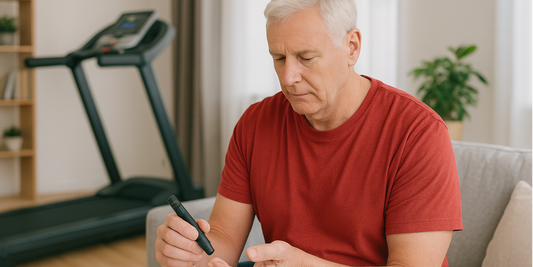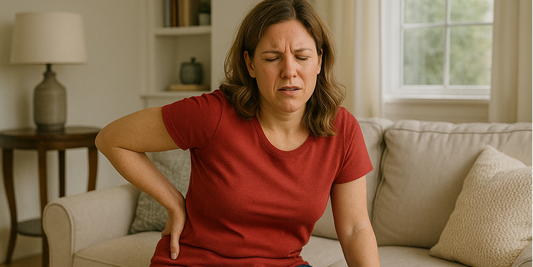
Understanding VO₂ Max, Heart Rate, and Fitness in Seniors: A Beginner’s Guide
Share
Staying active is one of the most powerful ways seniors can maintain independence, improve heart health, and boost overall well-being. But fitness doesn’t have to mean running marathons or lifting heavy weights. In fact, understanding a few key health indicators, like VO₂ Max and heart rate, can help older adults create a safe, effective exercise routine that supports healthy aging.
In this beginner-friendly guide, we’ll explore what VO₂ Max and heart rate mean, why they matter, and how something as simple as treadmill walking can support senior health.
What Is VO₂ Max and Why It Matters for Seniors?
1 - Definition of VO₂ Max
VO₂ Max stands for “maximum oxygen uptake.” It’s a measure of how much oxygen your body can use during physical activity. In simpler terms, it shows how efficiently your heart, lungs, and muscles work together when you're moving, especially during aerobic exercises like walking or light jogging.
The higher your VO₂ Max, the better your cardiovascular fitness. While it’s a term often associated with athletes, it’s just as important, if not more so, for older adults.
2 - Importance of VO₂ Max for Seniors
As we age, VO₂ Max naturally declines. A lower VO₂ Max is linked to reduced endurance, faster fatigue, and increased health risks. But the good news is that even gentle, regular activity, such as walking on a treadmill, can help slow down or even reverse this decline.
Improving your VO₂ Max can:
- Enhance energy levels
- Support heart and lung health
- Improve your ability to perform daily tasks without tiring
- Reduce the risk of falls and hospitalizations
It’s not about pushing hard — it’s about staying consistent.
Heart Rate: A Simple Tool for Monitoring Your Health
1 - Understand Your Resting and Target Heart Rate Zones

Resting heart rate (RHR) is how fast your heart beats when you’re at rest. For most seniors, a healthy RHR is between 60 and 80 beats per minute. If it’s consistently above or below that range, it may be worth discussing with your doctor.
When you exercise, your heart rate naturally increases. That’s where target heart rate zones come in. These zones help you understand how hard you're working and whether you're in a safe and effective range.
For seniors, a common target is 50–70% of your maximum heart rate. You can estimate your maximum heart rate with this simple formula:
220 – your age = max heart rate
For example, a 70-year-old would have an estimated max heart rate of 150 bpm. So, their ideal target heart rate zone would be around 75–105 bpm during moderate exercise.
2 - How to Safely Monitor Heart Rate During Treadmill Walking

Many modern treadmills have built-in heart rate monitors, often in the handles, that can help track your heart rate in real time. You can also use:
- A fitness tracker (e.g., Fitbit, Apple Watch)
- A chest-strap heart monitor (for more accuracy)
- Manual checking: Place your fingers on your wrist or neck and count beats for 15 seconds, then multiply by 4.
Start slow, stay within your comfort zone, and gradually increase your walking time. Even a 15-minute session can offer significant benefits.
How Treadmill Walking Supports Cardiovascular Health

Treadmill walking is one of the best low-impact exercises for older adults. It’s easy on the joints, doesn’t require outdoor weather, and allows you to control speed and incline.
Consistent walking can:
- Strengthen the heart muscle
- Lower blood pressure
- Improve circulation
- Reduce cholesterol
- Enhance lung function
For seniors dealing with arthritis or balance concerns, treadmills with handrails provide additional stability and safety. And remember, you don’t need to go fast or far. It’s the routine, not the intensity, that leads to long-term health improvements.
Easy Ways to Track Your Progress
1 - Use Simple Tools
Technology doesn’t have to be complicated. Many treadmills now come with simple displays showing speed, time, distance, and heart rate. For example, the Redliro treadmill with handrails includes these tracking features, making it a great companion for seniors to exercise safely at home. Basic fitness trackers or smartwatches can monitor your steps and even estimate your VO₂ Max over time.
If you prefer a low-tech option, keeping a notebook with your daily walking time and how you felt afterward is a great way to stay motivated.
2 - Check with Your Doctor
Before starting a new exercise program, especially if you have existing heart conditions, joint pain, or haven’t been active for a while, consult your doctor. They may recommend a safe starting point or even refer you to a physical therapist for guided activity.
Conclusion
Getting older doesn’t mean giving up on fitness; it just means approaching it wisely. By understanding VO₂ Max, heart rate, and how your body responds to movement, you can make informed choices that protect your health and strengthen your body.
Treadmill walking offers a simple, safe, and effective way for seniors to stay active at home. Start small, be consistent, and celebrate every step forward, because every step is an investment in your independence and quality of life.





